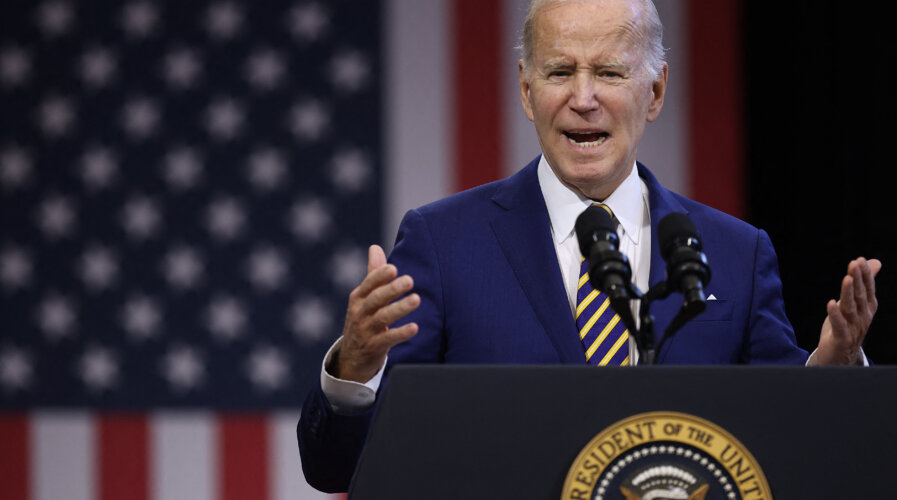
Chip 4 Alliance: The first meeting of senior officials finally transpired (Photo by CHIP SOMODEVILLA / GETTY IMAGES NORTH AMERICA / Getty Images via AFP)
Chip 4 Alliance: Senior officials finally meet to discuss semiconductor supply chain
- Senior officials of each country in the Chip 4 Alliance held their first meeting last week after months of coordination, according to Reuters.
- The topic of discussion was mainly the semiconductor supply chain and ways all parties can cooperate in the future.
The Chip 4 Alliance, a semiconductor working group initiated by the United States (US) in late 2021, is finally gearing up for more collaboration and concerted efforts, as senior officials from each country met for the first time last week. The meeting between the US, South Korea, Japan, and Taiwan senior officials took place virtually on February 16, following months of coordination.
To recall, the preliminary meeting of the Chip 4 Alliance took place last September, but it only involved working-level officials from the four governments. This time, Taiwan’s foreign ministry said the “US-East Asia Semiconductor Supply Chain Resilience Working Group“, or “Fab 4”, had, after many months of coordination, held the first video meeting of senior officials from its working group on February 16.
“The focus of the discussions of the participating quartet at the meeting was mainly on how to maintain the resilience of the semiconductor supply chain and explore the possible future cooperation directions of all parties,” the Taiwanese ministry said in a statement. The ministry, however, did not elaborate on which officials took part in the call.
“As an important member of the Indo-Pacific region, our country also plays a key role in the global semiconductor industry and has deep economic and trade relations with countries in the region,” the ministry added. The countries that are members of the group in the Indo-Pacific region are home to some of the world’s largest contract chip makers.
That includes Taiwan Semiconductor Manufacturing Co Ltd, South Korean memory chip giants Samsung Electronics Co Ltd, and SK Hynix, with Japan being the supplier of materials and equipment required to make the semiconductors. With the US as a chip design powerhouse and the other three countries having top capabilities in manufacturing and production of critical equipment and materials, the envisioned alliance would cover all major areas of the chips value chain.
In an interview with the New York Times last year, South Korean President Yoon Suk-yeol said the Chip 4 alliance is “necessary” for the four countries to closely communicate on the semiconductor industry, despite fears that doing so could anger China. Under Yoon, South Korea joined the Indo-Pacific Economic Framework, often seen as an American-led effort to counter China in the race to secure global supply chains.
In response, China has criticized the alliance as an entity aimed at containing China’s growing influence in the industry and opposed South Korea’s joining the grouping. There have also been arguments that, to date, the Chip 4 Alliance has remained a proposed working group with no clear indication of when it will be fortified.
While two virtual meetings have been held to date, no concrete outcome has come from the meetings besides the intention to drive technological breakthroughs and withstand supply disruption emanating from trade conflicts or geopolitical tensions. But for China, it’s growing to be more complicated with the mounting export controls from the US.
To top it off, the Biden administration last month secured support from Tokyo and The Hague to tighten export controls on advanced chip manufacturing equipment and technologies to China. The move will make it increasingly difficult for Dutch and Japanese suppliers to sell to Chinese clients.
It is undeniable that recent developments in the US-China technology war have reshaped the future of the semiconductor industry, which has become a hot-button issue in geopolitics. Perhaps one of the most pressing expositions in the midst of the ‘chip war’ is a bunch of vulnerabilities in China’s semiconductor manufacturing capability and strength.
Although in the short run, US measures may topple China’s advancement, in the long run, the chokepoints set by the US measures may soon become less effective. Experts have also argued that a chunk of big and small Chinese companies will eventually find ways to manipulate loopholes in US regulations if efforts to enforce a blockade are ineffective.
When the US first announced its most aggressive measures against China last October, experts reckoned that the effort could backfire without buy-in from foreign partners and allies. Given the complexity of global supply chains, assistance from allied semiconductor states – especially fellow chip-making tool producers Japan and the Netherlands – is critical to restrict Chinese access to the materials, equipment, and advanced chips that enable production.
So far, the US is heading in the right direction since it has successfully gathered support and partnership with major chip producers in Europe and Asia. It is left to see how the Chip 4 Alliance will play out against China and if there will be counter measures from the latter.
READ MORE
- Ethical AI: The renewed importance of safeguarding data and customer privacy in Generative AI applications
- How Japan balances AI-driven opportunities with cybersecurity needs
- Deploying SASE: Benchmarking your approach
- Insurance everywhere all at once: the digital transformation of the APAC insurance industry
- Google parent Alphabet eyes HubSpot: A potential acquisition shaping the future of CRM


